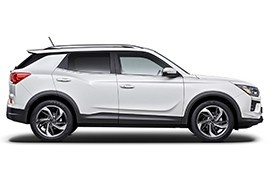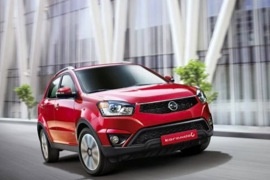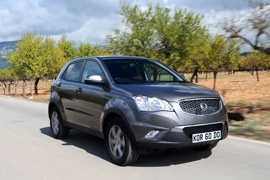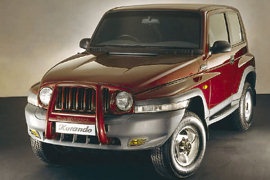
SSANGYONG Korando
Generations Timeline, Specs and Pictures

SsangYong has gone through big changes after it was taken over by Mahindra&Mahindra Industry.
Now it came up with the new Korando, which is trying to storm the SUV market with a vehicle designed for active families, who are looking for an active lifestyle but on a budget that won’t break their banks.
The design has a new striking appearance, with a bold new face, with flat and straight lines across the frontal grill. On the rear, wheel arches are extended up with shoulders, emphasizing the muscular lines of the vehicle. It is the same design language launched back in 2015 by the Tivoli and, two years later, by the Rexton G4 SUV.
Inside the cabin, SsangYong offers a new 10.25” LCD screen for the infotainment system, which is compatible with both Apple CarPlay and Android Auto.
Under the hood the Koreans are offering two powerplants: a 1,5 GDI-turbo and a 1.6 turbodiesel, which are offering 163 and 136 HP, respectively. Both can be coupled with a 6 speed manual or a 6 speed automatic transmission from AISIN. The diesel unit can tow up to two tons on the automatic transmission, and 1.5 tons on any other combination of engines and transmissions.
From the safety point of view, Korando has the new Advanced Emergency Braking System (AEBS), which is supplemented with a camera and a radar, to help achieve high grades for its lane keep assist and the adaptive cruise control.

After finding its way out of bankruptcy thanks to the Indian industrial group Mahindra&Mahindra, the Korean carmaker SsangYong started to upgrade its brand power.
SsangYong was on the verge of introducing new cars in its lineup and, after the Tivoli and Tivoli XLV, it introduced a facelift for its compact SUV Korando. Believe it or not, Korando is an acronym for the Korean Can Do and showed its commitment to be successful in the crossover and SUV segments. It was the second facelift for the third generation of the compact SUV since its launch in 2010.
There were mild updates on the exterior. Apart from the sharper headlights and bigger fog-lights, the 2017 Korando featured curved slats on the grille. In the back, there were minimal differences noticed, especially on the slightly different bumper design. The carmaker was not so eager to apply too many modifications since it was already under the last mile to launch a new Korando generation.
Inside, the carmaker introduced new colors for the vents and a new steering wheel, depending on the trim level. Other than that, it kept the same four seated heats and the 7” touch-screen display for the infotainment system that allowed iPod and Bluetooth connectivity.
Under the hood, SsangYong had to introduce a new Euro 6 turbo-diesel engine. Thus, the car was ready to comply with European regulations. A 2.0-liter gasoline engine was available as well. Both engine versions were available with either a front- or an all-wheel-drive system.

The 2013 Korando C represents the first important facelift applied to the third-generation compact SUV.
Sporting a new front bumper, restyled front grille, modern LED-infused headlamps, revised taillights and larger spoiler, the new Korando has gained a touch of a aggressiveness compared to the model it replaces. The Korean automaker updated the interior as well, adding new dashboard and instrumentation, higher quality materials (including wood trim) and a new infotainment system. The 2.0-liter engine is tuned to deliver either 149 HP or 181 HP, while all-wheel drive can be had as an option.

SsangYong introduced the third generation of the Korando range in 2010, and it was a good offer on the compact SUV market.
SsangYong went through some financial difficulties, and it was bought by the Indian group Mahindra&Mahindra. The 2010 Korando, an acronym for Korean, was developed on an entirely new platform. While SsangYong built its predecessors on a ladder-chassis, the third generation was based on a unibody construction, which greatly improved ride and comfort, even though it wasn’t a true off-road vehicle. The Korean carmaker offered the car with a front, or all-wheel drive.
The design showed a huge improvement over its predecessors, not only on its range but also on the SsangYong lineup. With its angled, big headlights and the silver mesh-grille, it looked like a modern SUV, not as a rugged off-road vehicle designed by a beginner in the automotive industry.
The interior offered enough room for up to five adults, with bucket seats at the front and a bench in the rear. Moreover, the floor was flat, without any intrusion from the transmission tunnel, making the middle seat more useable. There was a downside, though, with the material quality, which didn’t look as good as other Korean SUVs.
Under the hood, SsangYong installed two engine choices, both with two liters displacement. They were paired with either a 6-speed manual or a 6-speed automatic transmission.

Sold under the Daewoo brand in some countries, such as the U.K., the Korando was an inexpensive off-road vehicle built in Korea.
The name Korando, believe-it or not, came from “Korean can do” and reflected the manufacturer’s confidence in that vehicle. Imagine that it was covered by three years, 60.000 miles (97.000 km) warranty with free service, free pick-up and delivery, and free towing if anything went south on the road.
The exterior design was, to say at least, not the most inspired part of the vehicle. It showed a narrow engine compartment and flared wheel arches. Its vertical slats and round headlights resembled the old Jeeps. And there were the huge turn signals installed between the wrap-around plastic bumper and the front fenders. There was the same theme with flared arches in the rear, but not so obvious as in the front. The spare wheel was mounted on the tailgate.
Inside, it was unclear if the manufacturer addressed the car to ordinary people or to those who wished for an up-market vehicle, but they couldn’t afford one. Some wood trims on the center console enhanced the look for the upper trim levels, while silver plastic panels tried hard to look like aluminum for the other versions. There was plenty of room for the front occupants and limited for the rear ones. As for the trunk, you’d better forget it.
Under the hood, SsangYong installed engines licensed from Mercedes-Benz. There was a four-pot 2.3-liter unit for the entry-level than a 3.2-liter V6 for the top version. One of the best versions was the inline-five, 2.9-liter engine, which was also produced under license from the same German carmaker.























































